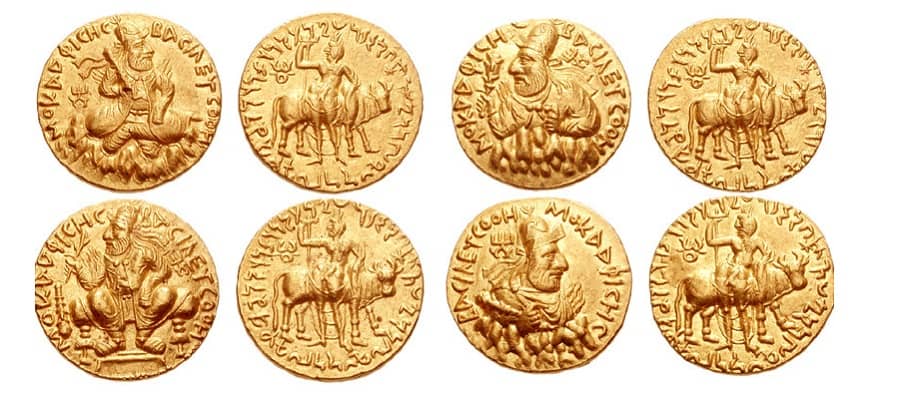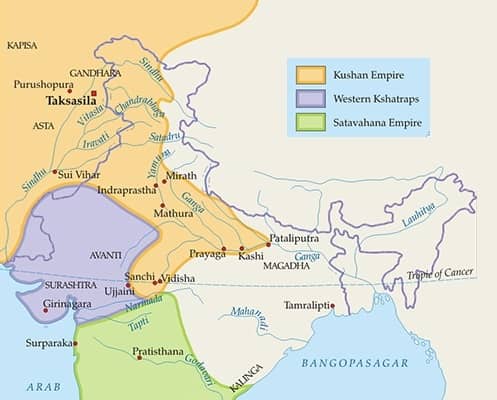Contents
>>>>>>>
Origins Kushan Dynasty
- Kushan dynasty is considered to be one of the five branches of the Yuezhi tribe.
- They lived in the Chinese frontier or central Asia.
- Kushan dynasty is known as Guishuang in Chinese sources.
- They eventually acquired dominance over the other Yuezhi tribes.
- Kushan dynasty rulers moved eastward towards India defeating the Parthians and the Shakas in the 1st century AD.
>>>>>>
>>>>>>>
Rulers of Kushan Dynasty
Kujula Kadphises (15-64 AD)
- Kujula Kadphises laid the foundation of the Kushan Empire in India.
- He amalgamated the five clans of Yue-chi tribes
- He also known as Kadphises I.
- Kujula kadphises established his supremacy over Kabul, Kandahar and Afghanistan.
- He minted coins in copper.
- His coins also suggest an association with Buddhism.
>>>>>>>
Vima Kadphises (64 – 78)
- An inscription found at Rabatak in Afghanistan mentions that he was the son of Vima Taktu and the father of Kanishka.
- He is also known as Wema Kadphises II.
- He conquered Gandhara from the Parthians and further spread the kingdom till Mathura region.
- Vima Kadphises has issued a large number of gold coins.
- He was a Shiva devotee as is clear from coins issued by him.
- The large number of Roman gold coins found from the Kushan era, indicates good trade with the Romans.
>>>>>>>
Kanishka (78 – 101)
- Kanishka is considered as the greatest Kushan dynasty king.
- His main capital was Peshawar, then known as Purushpura.
- He had second capital in Mathura.
- After the capture of Pataliputra, he took away the Buddhist monk Ashvaghosha with him to Peshawar.
- The scholars in the court of Kanishka included
- Ashvaghosha – wrote the Buddhacharita
- Vasumitra – a philosopher who authored Mahavibhasa
- Nagarjuna – propounded the Prajna Paramita Sutra
- Charaka – father of Ayurveda, wrote Charaksamhita and Sasruta
- Agesilaus – a Greek engineer, built the great stupa of Purushapura
- The Rabatak Inscription (Afghanistan) presents valuable information on Kanishka.
- Kanishka started the Shaka era in 78 which is accepted as the beginning of his reign.
- He adopted the title of ‘Devputra’.
- Kanishka convened the 4th Buddhist Council at Kundalvana in Kashmir.
- He patronised Buddhism although he was very tolerant in his religious views.
- Coins of Kanishka contain a mix of Indian, Greek and Zoroastrian deities.
- The Gandhara School of art flourished under Kushan dynasty.
- Kanishka also propagated Mahayana form of Buddhism, and he was largely responsible for propagating it in China.
>>>>>>>

>>>>>>>
Decline of the Kushan Empire
- Kushan empire power gradually declined from the early third century
- Kanishka was succeeded by his son Vasishka.
- Vasishka was followed by Huvishka and Kanishka II (son of Vasishka).
- Kanishka II was followed by Vasudeva I, who was worshipper of Shiva
- Vasudeva I was the last great king of the Kushan dynasty.
- After his death in 232 AD the empire disintegrated away.
>>>>>>>
>>>>>>>
Significance of the Kushan Empire
- The political significance of the Kushan empire lies in the integration of central Asia with north India as a part of a single empire.
- Sanskrit literature began to be developed during this time of Kushan dynasy.
- The 4th Buddhist council was held in Sanskrit language.
- Ashvoghosha is considered to be the 1st Sanskrit dramatist.
- During this time, three distinct schools of art flourished:
- Gandhara School in north-west India
- Amaravati School in Andhra
- Mathura School in the Ganges valley
- Trade prospered between India and China, and India and the Roman Empire.
- The Kushan Empire controlled large parts of the Silk Route which led to the propagation of Buddhism into China.
- In the time of Kushan dynasty rule Buddhism began to spread in Korea and Japan as well.
- Many towers, Chaityas, towns and beautiful sculptures were built under the patronage of the Kushan dynasty rulers.
- Kushan dynasty was foreign invaders in the starting, but they were completely Indianised in ways and culture.
- It is said that the Kushan period in Indian history was a perfect forerunner to the golden age of the Guptas.
>>>>>>





